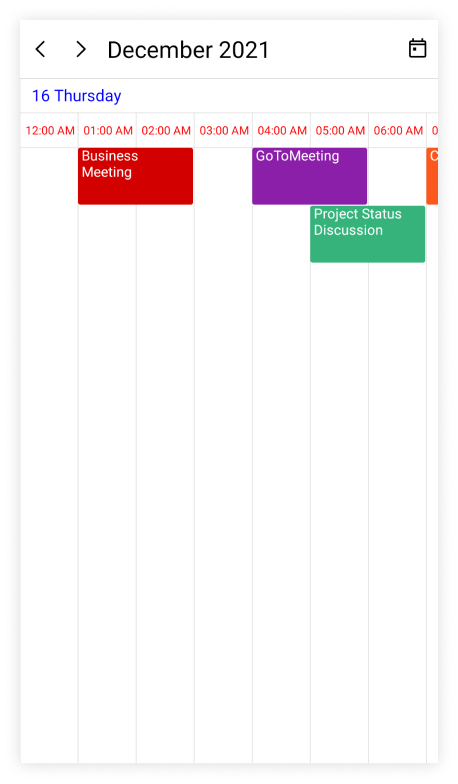Timeline Views in .NET MAUI Scheduler (SfScheduler)
17 Dec 202524 minutes to read
The timelineView displays the date inside the horizontal time axis with the desired count of each day. See the past or future dates by scrolling to the right or left. The appointments on a specific day will be arranged in the respective timeslots based on their duration.
-
Timeline day view: It displays a single day in the horizontal time axis of the Scheduler.
-
Timeline week view: It displays all the days of a week in horizontal time axis. The past or future dates can be viewed by scrolling to right or left.
-
Timeline work week view: It displays only the working days of a week in horizontal axis. By default, Saturday and Sunday are not working days. You can customize it with any day of the week.
-
Timeline month: A horizontal axis displaying appointments across all days of a month is displayed, where each column represents a single day.
Number of days visible in the timeline views
The .NET MAUI Scheduler number of visible days in the timeline day, timeline week, and timeline workweek can be adjusted by changing the NumberOfVisibleDays property of the TimelineView.
<scheduler:SfScheduler x:Name="Scheduler"
View="TimelineWeek">
<scheduler:SfScheduler.TimelineView>
<scheduler:SchedulerTimelineView
NumberOfVisibleDays="3"/>
</scheduler:SfScheduler.TimelineView>
</scheduler:SfScheduler>SfScheduler scheduler = new SfScheduler();
scheduler.View = SchedulerView.TimelineWeek;
scheduler.TimelineView.NumberOfVisibleDays = 3;
this.Content = scheduler;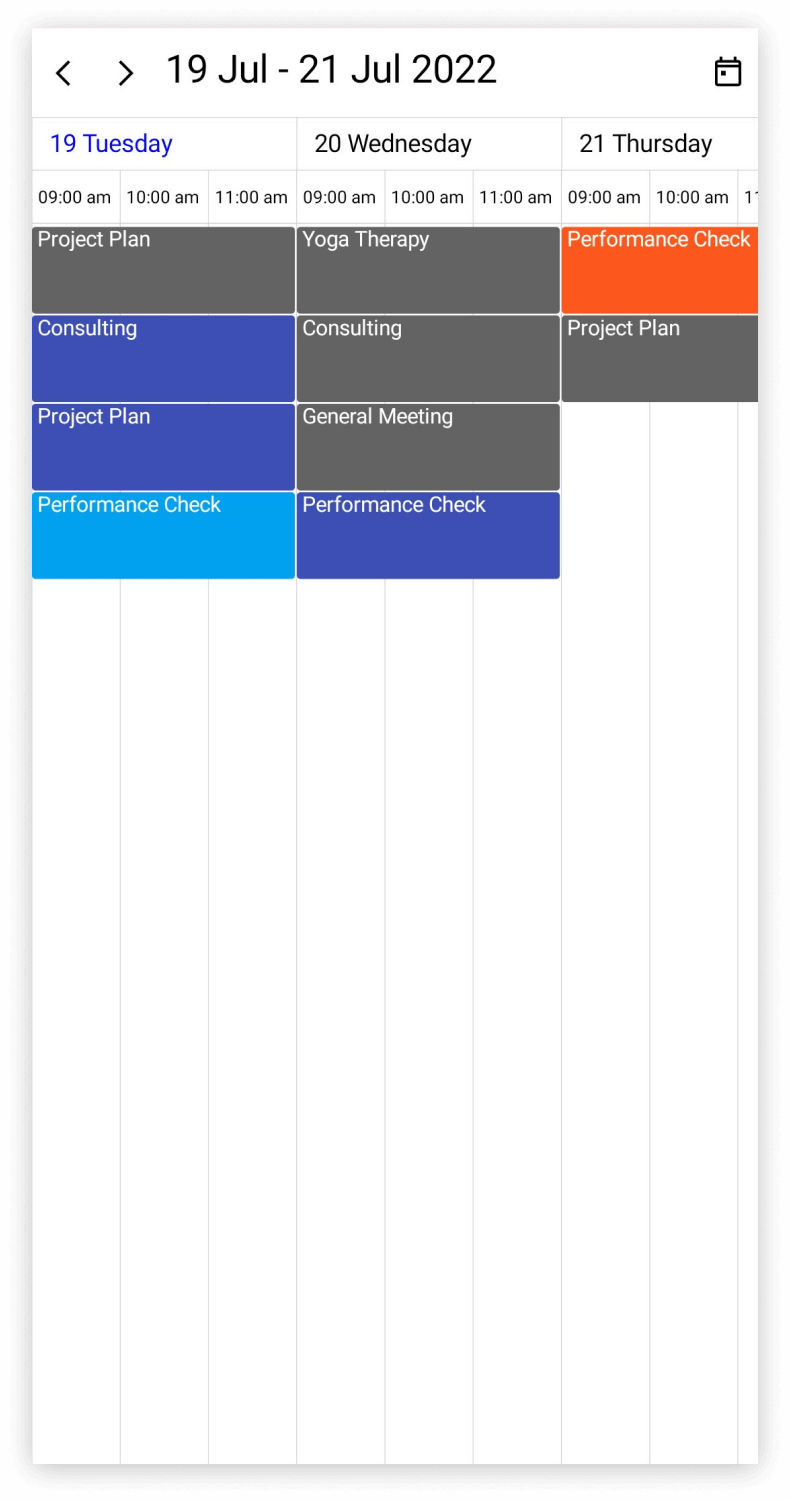
Change time interval
The time interval between the time slots in the timeline day, timeline week, and timeline workweek views can be customized by using the TimeInterval property of the TimelineView.
<scheduler:SfScheduler x:Name="Scheduler"
View="TimelineWeek">
<scheduler:SfScheduler.TimelineView>
<scheduler:SchedulerTimelineView
TimeInterval="2:0:0" />
</scheduler:SfScheduler.TimelineView>
</scheduler:SfScheduler>SfScheduler scheduler = new SfScheduler();
scheduler.View = SchedulerView.TimelineWeek;
scheduler.TimelineView.TimeInterval = new TimeSpan(2, 0, 0);
this.Content = scheduler;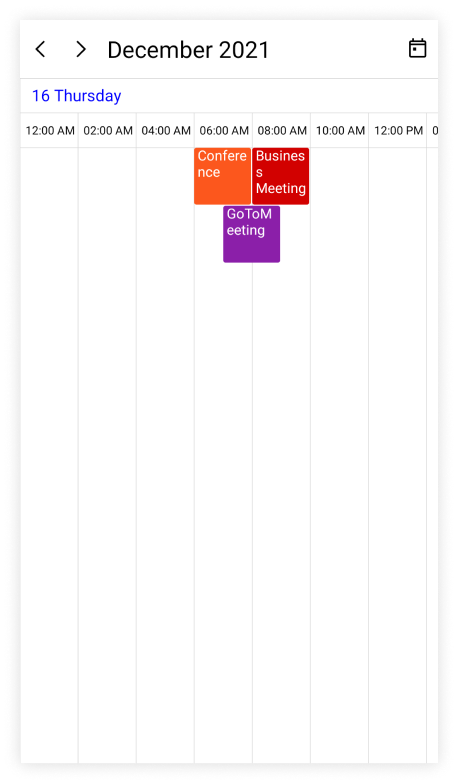
NOTE
To modify the
TimeIntervalvalue (in minutes), change the time labels format by setting theTimeRulerFormatvalue tohh:mm.
Change time interval width
The Time interval width can be customized for each time slot cell of the timeline day, timeline week, timeline workweek, and timeline month views by using the TimeIntervalWidth property of TimelineView.
<scheduler:SfScheduler x:Name="Scheduler"
View="TimelineWeek">
<scheduler:SfScheduler.TimelineView>
<scheduler:SchedulerTimelineView
TimeIntervalWidth="120" />
</scheduler:SfScheduler.TimelineView>
</scheduler:SfScheduler>SfScheduler scheduler = new SfScheduler();
scheduler.View = SchedulerView.TimelineWeek;
scheduler.TimelineView.TimeIntervalWidth = 120;
this.Content = scheduler;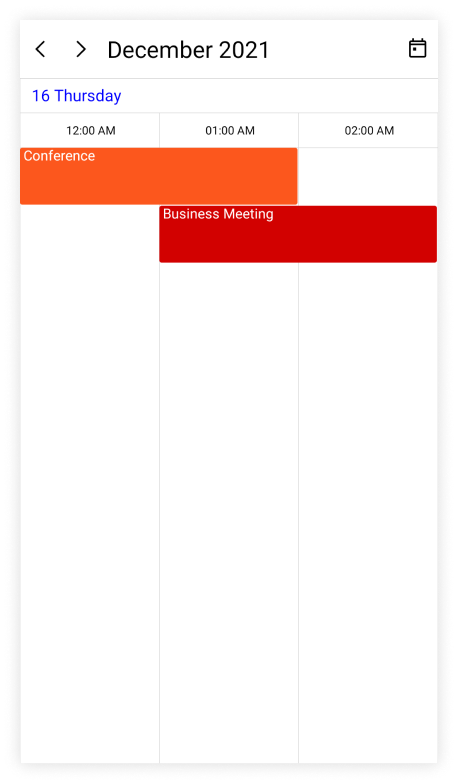
Flexible working days
By default, the .NET MAUI Scheduler considers the weekdays from Monday to Friday as working days. The days which are defined in this non-working days collection are considered as non-working days. Therefore, the weekend days are set to hide from the Scheduler.
The NonWorkingDays property of TimelineView can also be used to show only the nonworking days of the week.
<scheduler:SfScheduler x:Name="Scheduler"
View="TimelineWorkWeek">
<scheduler:SfScheduler.TimelineView>
<scheduler:SchedulerTimelineView
NonWorkingDays="Monday,Wednesday" />
</scheduler:SfScheduler.TimelineView>
</scheduler:SfScheduler>SfScheduler scheduler = new SfScheduler();
scheduler.View = SchedulerView.TimelineWeek;
scheduler.TimelineView.NonWorkingDays = SchedulerWeekDays.Monday | SchedulerWeekDays.Wednesday;
this.Content = scheduler;NOTE
The
Timeline workweekview displays exactly the defined working days on Scheduler control, whereas other views displays all the days.
Hide non-working days in timeline month
The HideNonWorkingDays property of the TimelineView allows you to control the visibility of non-working days in TimelineMonth. By default, the HideNonWorkingDays property is set to false.
<scheduler:SfScheduler x:Name="Scheduler"
View="TimelineMonth">
<scheduler:SfScheduler.TimelineView>
<scheduler:SchedulerTimelineView
NonWorkingDays="Monday,Wednesday" HideNonWorkingDays = "True"/>
</scheduler:SfScheduler.TimelineView>
</scheduler:SfScheduler>SfScheduler scheduler = new SfScheduler();
scheduler.View = SchedulerView.TimelineMonth;
scheduler.TimelineView.NonWorkingDays = SchedulerWeekDays.Monday | SchedulerWeekDays.Wednesday;
scheduler.TimelineView.HideNonWorkingDays = true;
this.Content = scheduler;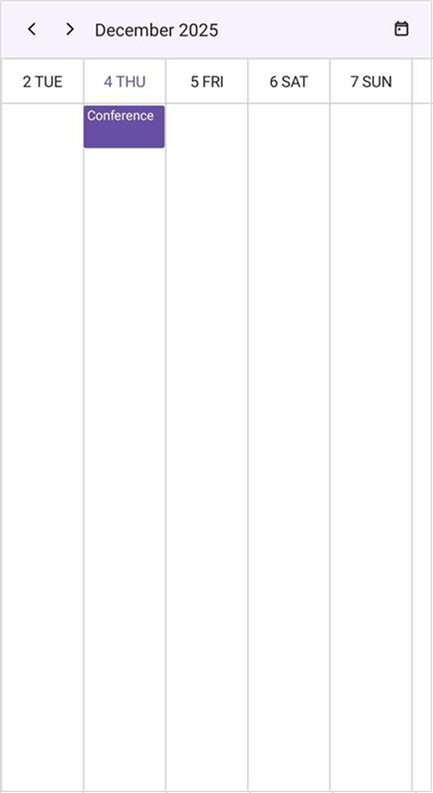
NOTE
The
HideNonWorkingDaysproperty will be applicable only forTimelineMonthview, and not be applicable for the remaining views.
Flexible working hours
The default values for StartHour and EndHour are 0 and 24 respectively, to show all the time slots for a timeline day, timeline week, or timeline workweek view. You may set these properties to show only the required time periods in TimelineView. You can set StartHour and EndHour in the time duration to show the required time duration in minutes.
<scheduler:SfScheduler x:Name="Scheduler"
View="TimelineWeek">
<scheduler:SfScheduler.TimelineView>
<scheduler:SchedulerTimelineView
StartHour="9"
EndHour="16" />
</scheduler:SfScheduler.TimelineView>
</scheduler:SfScheduler>SfScheduler scheduler = new SfScheduler();
scheduler.View = SchedulerView.TimelineWeek;
scheduler.TimelineView.StartHour = 9;
scheduler.TimelineView.EndHour = 16;
this.Content = scheduler;
NOTE
- The
NonWorkingDaysproperty will be applicable only forworkWeek,TimelineWorkWeekandTimelineMonthviews only, and not be applicable for the remaining views.- No need to specify the decimal point values for
StartHourandEndHour, if you do not want to set the minutes.- The number of time slots will be calculated based on total minutes of a day and time interval (total minutes of a day ((start hour - end hour) * 60) / time interval).
- If a custom timeInterval is given, then the number of time slots calculated based on the given
TimeIntervalshould result in an integer value (total minutes % timeInterval = 0), otherwise the next immediate time interval that results in integer value when dividing total minutes of a day will be considered. For example, if TimeInterval=2 Hours 15 minutes and total minutes = 1440 (24 Hours per day), then theTimeIntervalwill be changed to ‘144’ (1440%144=0) by considering (total minutes % TimeInterval = 0), it will return integer value for time slots rendering.- If the custom
StartHourandEndHourare given, then the number of time slots calculated based on the givenStartHourandEndHourshould result in integer value, otherwise the next immediateTimeIntervalwill be considered until the result is integer value. For example, if theStartHouris 9 (09:00AM),EndHouris 18.25 (06:15 PM),TimeIntervalis 30 minutes, and total minutes = 555 ((18.25-9)*60), then theTimeIntervalwill be changed to ’37 minutes’ (555%37=0) by considering (total minutes % timeInterval = 0) it will return the integer value for time slots rendering.
NOTE
Special time regions
The user interaction such as selection and highlights specific regions of timeline day, timeline week, and timeline workweek views can be restricted by adding the TimeRegions property of the TimelineView in the SfScheduler. You need to set the StartTime and EndTime properties of TimeRegions to create a specialTimeRegion, you can use the TimeZone property to set the specific timezone for start and end time of TimeRegions.
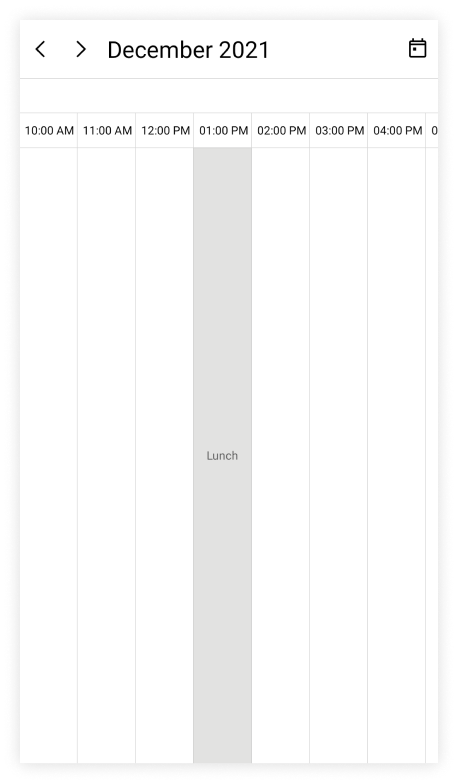
Watch the video below for a step-by-step guide on adding and customizing TimeRegions in .NET MAUI SfScheduler
Selection restriction in timeslots
You can enable or disable the touch interaction of TimeRegion using the EnablePointerInteraction property of TimeRegion. By default, its value is true.
<scheduler:SfScheduler x:Name="Scheduler"
View="TimelineWeek">
</scheduler:SfScheduler>this.Scheduler.View = SchedulerView.TimelineWeek;
this.Scheduler.TimelineView.TimeRegions = this.GetTimeRegion();
private ObservableCollection<SchedulerTimeRegion> GetTimeRegion()
{
var timeRegions = new ObservableCollection<SchedulerTimeRegion>();
var timeRegion = new SchedulerTimeRegion()
{
StartTime = DateTime.Today.Date.AddHours(13),
EndTime = DateTime.Today.Date.AddHours(14),
Text = "Lunch",
EnablePointerInteraction = false,
};
timeRegions.Add(timeRegion);
return timeRegions;
}NOTE
This property only restricts the interaction on region and it does not restrict the following:
- The Programmatic selection (if the user updates the selected date value dynamically).
- It does not clear the selection when the user selects the region and dynamically change the
EnablePointerInteractionproperty to false.- It does not restrict appointment interaction when the appointment placed in the region.
- It does not restrict the appointment rendering on a region, when the appointments are loaded from data services or added programmatically.
Recurring time region
The recurring time region on a daily, weekly, monthly, or yearly interval. The recurring special time regions can be created by setting the RecurrenceRule property in TimeRegion.
<scheduler:SfScheduler x:Name="Scheduler"
View="TimelineWeek">
</scheduler:SfScheduler>this.Scheduler.View = SchedulerView.TimelineWeek;
this.Scheduler.TimelineView.TimeRegions = this.GetTimeRegion();
private ObservableCollection<SchedulerTimeRegion> GetTimeRegion()
{
var timeRegions = new ObservableCollection<SchedulerTimeRegion>();
var timeRegion = new SchedulerTimeRegion()
{
StartTime = DateTime.Today.Date.AddHours(13),
EndTime = DateTime.Today.Date.AddHours(14),
Text = "Lunch",
EnablePointerInteraction = false,
RecurrenceRule = "FREQ=DAILY;INTERVAL=1",
};
timeRegions.Add(timeRegion);
return timeRegions;
}NOTE
Recurrence exception dates
Any occurrence that is an exception from the recurrence pattern time region can be deleted by using the RecurrenceExceptionDates property of TimeRegion. The deleted occurrence date will be considered as a recurrence exception date.
<scheduler:SfScheduler x:Name="Scheduler"
View="TimelineWeek">
</scheduler:SfScheduler>this.Scheduler.View = SchedulerView.TimelineWeek;
this.Scheduler.TimelineView.TimeRegions = this.GetTimeRegion();
private ObservableCollection<SchedulerTimeRegion> GetTimeRegion()
{
var timeRegions = new ObservableCollection<SchedulerTimeRegion>();
var recurrenceExceptionDates = DateTime.Now.Date.AddDays(3);
var timeRegion = new SchedulerTimeRegion()
{
StartTime = DateTime.Today.Date.AddHours(13),
EndTime = DateTime.Today.Date.AddHours(14),
Text = "Lunch",
EnablePointerInteraction = false,
RecurrenceRule = "FREQ=DAILY;INTERVAL=1",
RecurrenceExceptionDates = new ObservableCollection<DateTime>()
{
recurrenceExceptionDates,
}
};
timeRegions.Add(timeRegion);
return timeRegions;
}Customize special time region appearance
The special time region appearance customization can be achieved by using the TextStyle and TimeRegionTemplate properties of TimelineView in the SfScheduler.
Customize special time region appearance using style
The specialTimeRegion background and text style can be customized by using the Background and TextStyle properties of TimeRegion that is used to customize the background color for time region background and text style for the text of the specialTimeRegion.
<scheduler:SfScheduler x:Name="Scheduler"
View="TimelineWeek">
</scheduler:SfScheduler>this.Scheduler.View = SchedulerView.TimelineWeek;
this.Scheduler.TimelineView.TimeRegions = this.GetTimeRegion();
private ObservableCollection<SchedulerTimeRegion> GetTimeRegion()
{
var textStyle = new SchedulerTextStyle()
{
TextColor = Colors.DarkBlue,
FontSize = 14,
};
var timeRegions = new ObservableCollection<SchedulerTimeRegion>();
var timeRegion = new SchedulerTimeRegion()
{
StartTime = DateTime.Today.Date.AddHours(13),
EndTime = DateTime.Today.Date.AddHours(14),
Text = "Lunch",
EnablePointerInteraction = false,
Background = Brush.Orange,
TextStyle = textStyle
};
timeRegions.Add(timeRegion);
return timeRegions;
}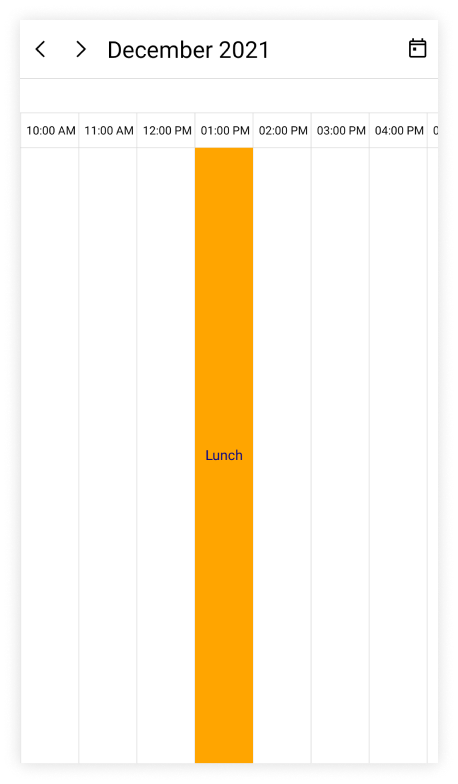
Customize special time region appearance using DataTemplate
You can customize the time region appearance by using the TimeRegionTemplate property of TimelineView in the SfScheduler.
<scheduler:SfScheduler x:Name="Scheduler"
View="TimelineWeek">
<scheduler:SfScheduler.TimelineView>
<scheduler:SchedulerTimelineView>
<scheduler:SchedulerTimelineView.TimeRegionTemplate>
<DataTemplate>
<Grid Background="MediumPurple" >
<Label HorizontalOptions="Center" TextColor="White" VerticalOptions="Center" Text="{Binding Text}" />
</Grid>
</DataTemplate>
</scheduler:SchedulerTimelineView.TimeRegionTemplate>
</scheduler:SchedulerTimelineView>
</scheduler:SfScheduler.TimelineView>
</scheduler:SfScheduler>this.Scheduler.View = SchedulerView.TimelineWeek;
this.Scheduler.TimelineView.TimeRegions = this.GetTimeRegion();
private ObservableCollection<SchedulerTimeRegion> GetTimeRegion()
{
var timeRegions = new ObservableCollection<SchedulerTimeRegion>();
var timeRegion = new SchedulerTimeRegion()
{
StartTime = DateTime.Today.Date.AddHours(13),
EndTime = DateTime.Today.Date.AddHours(14),
Text = "Lunch",
EnablePointerInteraction = false,
Background = Brush.Orange,
};
timeRegions.Add(timeRegion);
return timeRegions;
}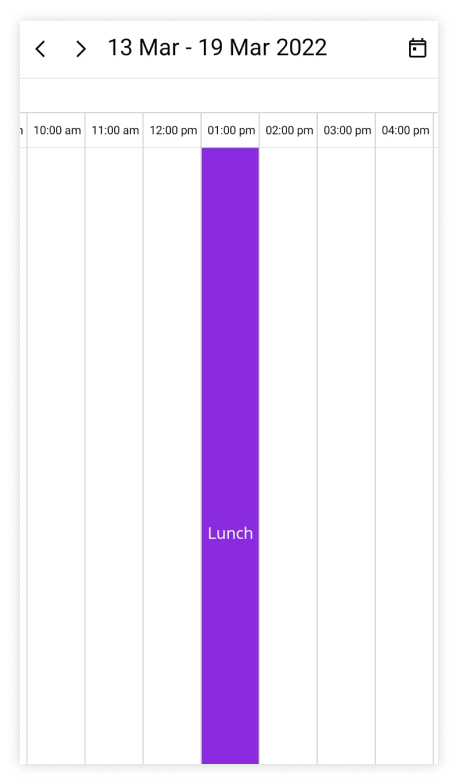
Customize special time region appearance using DataTemplateSelector
You can customize the time region appearance by using the TimeRegionTemplate property of TimelineView in the SfScheduler. The DataTemplateSelector can choose a DataTemplate at runtime based on the value of a data-bound to scheduler time region by using the TimeRegionTemplate. It allows you to choose a different data template for each time region, as well as customize the appearance of a particular time region based on certain conditions.
<Grid>
<Grid.Resources>
<DataTemplate x:Key="timeRegiontemplate">
<Grid Background = "LightCyan" Opacity="0.5">
<Label x:Name="label" HorizontalOptions="Center" TextColor="Red" Text="{Binding Text}" VerticalOptions="Center" />
</Grid>
</DataTemplate>
<DataTemplate x:Key="timeRegiontemplate1">
<Grid Background = "Lightgreen" Opacity="0.5">
<Label x:Name="label" HorizontalOptions="Center" TextColor="Orange" Text="{Binding Text}" VerticalOptions="Center" />
</Grid>
</DataTemplate>
<local:TimeRegionTemplateSelector x:Key="timeRegionTemplateSelector" TimeRegionsTemplate="{StaticResource timeRegiontemplate}" TimeRegionsTemplate1="{StaticResource timeRegiontemplate1}" />
</Grid.Resources>
<scheduler:SfScheduler x:Name="Scheduler"
View="TimelineWeek">
<scheduler:SfScheduler.TimelineView>
<scheduler:SchedulerTimelineView TimeRegionTemplate = "{StaticResource timeRegionTemplateSelector}"/>
</scheduler:SfScheduler.TimelineView>
</scheduler:SfScheduler>
</Grid>public class TimeRegionTemplateSelector : DataTemplateSelector
{
public TimeRegionTemplateSelector()
{
}
public DataTemplate TimeRegionsTemplate { get; set; }
public DataTemplate TimeRegionsTemplate1 { get; set; }
protected override DataTemplate OnSelectTemplate(object item, BindableObject container)
{
var timeRegionDetails = item as SchedulerTimeRegion;
if (timeRegionDetails.EnablePointerInteraction)
return TimeRegionsTemplate;
return TimeRegionsTemplate1;
}
}this.Scheduler.View = SchedulerView.TimelineWeek;
this.Scheduler.TimelineView.TimeRegions = this.GetTimeRegion();
private ObservableCollection<SchedulerTimeRegion> GetTimeRegion()
{
var timeRegions = new ObservableCollection<SchedulerTimeRegion>();
var timeRegion = new SchedulerTimeRegion()
{
StartTime = DateTime.Today.Date.AddHours(13),
EndTime = DateTime.Today.Date.AddHours(14),
Text = "Lunch",
RecurrenceRule = "FREQ=DAILY;INTERVAL=1",
EnablePointerInteraction = true,
};
var timeRegion1 = new SchedulerTimeRegion()
{
StartTime = DateTime.Today.Date.AddHours(17),
EndTime = DateTime.Today.Date.AddHours(18),
Text = "Break",
RecurrenceRule = "FREQ=DAILY;INTERVAL=1",
Background = Brush.Red,
EnablePointerInteraction = false,
};
timeRegions.Add(timeRegion);
timeRegions.Add(timeRegion1);
return timeRegions;
}NOTE
- The BindingContext of the
TimeRegionTemplateis theSchedulerTimeRegion.- When using data template selector, performance issues occur as the conversion template views take time within the framework.
Full screen scheduler
The .NET MAUI Scheduler time interval width can be adjusted based on screen width by changing the TimeIntervalWidth property of TimelineView to -1. It will auto-fit the timeline day, timeline week and timeline work week views to the screen width.
<scheduler:SfScheduler x:Name="Scheduler"
View="TimelineDay">
<scheduler:SfScheduler.TimelineView>
<scheduler:SchedulerTimelineView
TimeIntervalWidth="-1" />
</scheduler:SfScheduler.TimelineView>
</scheduler:SfScheduler>SfScheduler scheduler = new SfScheduler();
scheduler.View = SchedulerView.TimelineDay;
scheduler.TimelineView.TimeIntervalWidth = -1;
this.Content = scheduler;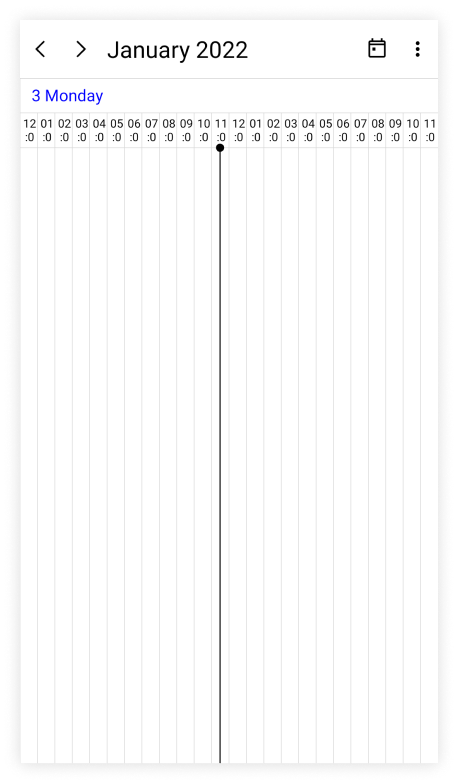
Show current time indicator
You can show or hide the current time indicator in timeline day, timeline week, and timeline workweek views of SfScheduler by using the ShowCurrentTimeIndicator property of TimelineView, and by default, its true.
<scheduler:SfScheduler x:Name="Scheduler"
View="TimelineWeek">
<scheduler:SfScheduler.TimelineView>
<scheduler:SchedulerTimelineView
ShowCurrentTimeIndicator="False"/>
</scheduler:SfScheduler.TimelineView>
</scheduler:SfScheduler>SfScheduler scheduler = new SfScheduler();
scheduler.View = SchedulerView.TimelineWeek;
scheduler.TimelineView.ShowCurrentTimeIndicator = false;
this.Content = scheduler;Customize current time indicator appearance
The current time indicator can be customized by using the CurrentTimeIndicatorBrush property of TimelineView in the SfScheduler.
<scheduler:SfScheduler x:Name="Scheduler"
View="TimelineWeek">
<scheduler:SfScheduler.TimelineView>
<scheduler:SchedulerTimelineView
CurrentTimeIndicatorBrush="Green" />
</scheduler:SfScheduler.TimelineView>
</scheduler:SfScheduler>SfScheduler scheduler = new SfScheduler();
scheduler.View = SchedulerView.TimelineWeek;
scheduler.TimelineView.CurrentTimeIndicatorBrush = Brush.Green;
this.Content = scheduler;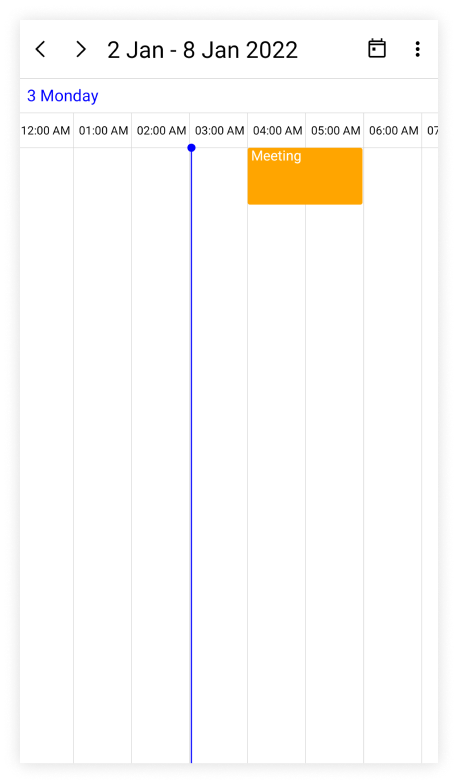
NOTE
The current time indicator color is applied only when the
ShowCurrentTimeIndicatorproperty is enabled.
Change time ruler height
The TimeRulerHeight property of TimelineView can be used to customize the size of the time ruler view where the labels with the time are placed.
<scheduler:SfScheduler x:Name="Scheduler"
View="TimelineWeek">
<scheduler:SfScheduler.TimelineView>
<scheduler:SchedulerTimelineView
TimeRulerHeight="100" />
</scheduler:SfScheduler.TimelineView>
</scheduler:SfScheduler>SfScheduler scheduler = new SfScheduler();
scheduler.View = SchedulerView.TimelineWeek;
scheduler.TimelineView.TimeRulerHeight = 100;
this.Content = scheduler;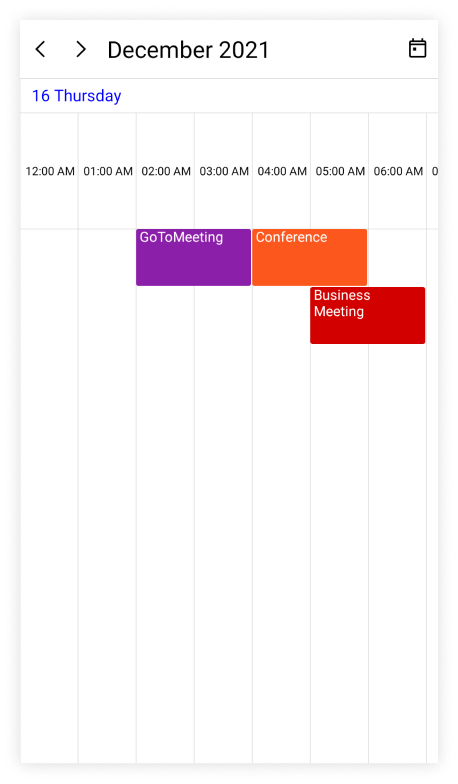
Minimum appointment duration
The MinimumAppointmentDuration property allows to set an arbitrary height to appointments which have a minimum duration in the timeline day, timeline week, and timeline workweek views so that the subject can be readable.
<scheduler:SfScheduler x:Name="Scheduler"
View="TimelineWeek">
<scheduler:SfScheduler.TimelineView>
<scheduler:SchedulerTimelineView
MinimumAppointmentDuration="0:30:0" />
</scheduler:SfScheduler.TimelineView>
</scheduler:SfScheduler>SfScheduler scheduler = new SfScheduler();
scheduler.View = SchedulerView.TimelineWeek;
scheduler.TimelineView.MinimumAppointmentDuration = new TimeSpan(0, 30, 0);
this.Content = scheduler;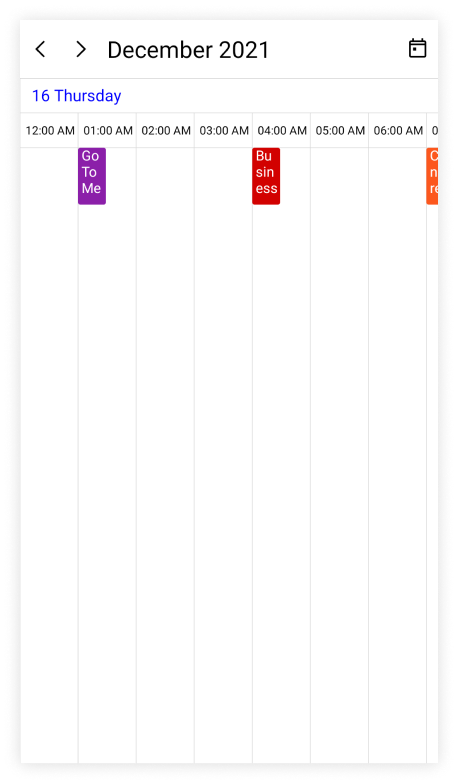
NOTE
- The
MinimumAppointmentDurationvalue will be set when an appointment duration value is lesser thanMinimumAppointmentDuration.- Appointment duration value will be set when the appointment duration value is greater than
MinimumAppointmentDuration.- The
TimeIntervalvalue will be set when theMinimumAppointmentDurationis greater thanTimeIntervalwith lesser appointment duration.- The all-day appointment does not support
MinimumAppointmentDuration.
NOTE
View header
You can customize the default appearance of view header in a timeline views by setting the DateFormat, DayFormat, Background, DateTextStyle, DayTextStyle, Height, and ViewHeaderTemplate properties of TimelineView in the SfScheduler.
View header text formatting
The date and day format of SfScheduler view header can be customized by using the DateFormat and DayFormat properties of TimelineView.
<scheduler:SfScheduler x:Name="Scheduler"
View="TimelineWeek">
<scheduler:SfScheduler.TimelineView>
<scheduler:SchedulerTimelineView>
<scheduler:SchedulerTimelineView.ViewHeaderSettings>
<scheduler:SchedulerViewHeaderSettings DayFormat="dddd"
DateFormat="MMMM dd"/>
</scheduler:SchedulerTimelineView.ViewHeaderSettings>
</scheduler:SchedulerTimelineView>
</scheduler:SfScheduler.TimelineView>
</scheduler:SfScheduler>SfScheduler scheduler = new SfScheduler();
scheduler.View = SchedulerView.TimelineWeek;
scheduler.TimelineView.ViewHeaderSettings.DayFormat = "dddd";
scheduler.TimelineView.ViewHeaderSettings.DateFormat = "MMMM dd";
this.Content = scheduler;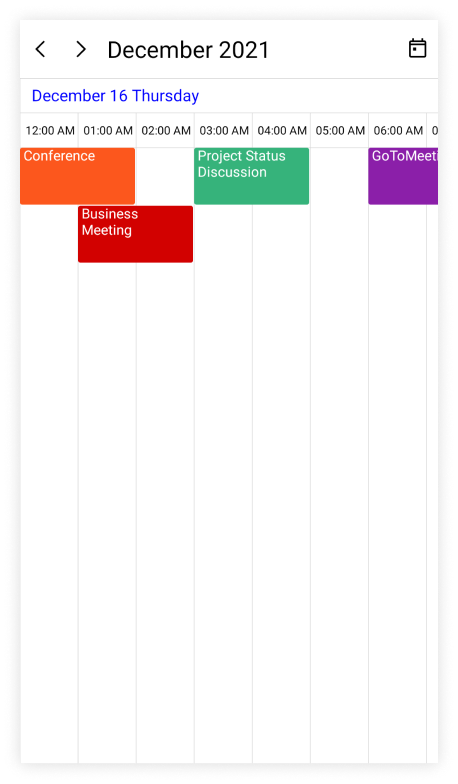
View header height
The height of the ViewHeader can be customized by setting the Height property of ViewHeaderSettings in TimelineView.
<scheduler:SfScheduler x:Name="Scheduler"
View="TimelineWeek">
<scheduler:SfScheduler.TimelineView>
<scheduler:SchedulerTimelineView>
<scheduler:SchedulerTimelineView.ViewHeaderSettings>
<scheduler:SchedulerViewHeaderSettings Height="100" />
</scheduler:SchedulerTimelineView.ViewHeaderSettings>
</scheduler:SchedulerTimelineView>
</scheduler:SfScheduler.TimelineView>
</scheduler:SfScheduler>SfScheduler scheduler = new SfScheduler();
scheduler.View = SchedulerView.TimelineWeek;
scheduler.TimelineView.ViewHeaderSettings.Height = 100;
this.Content = scheduler;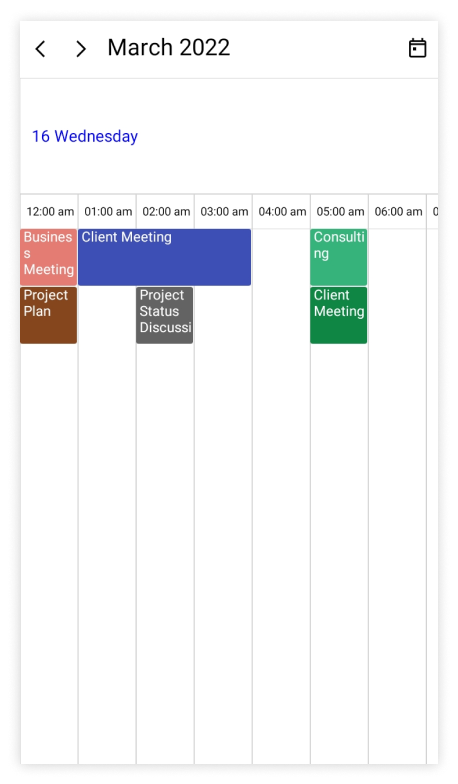
Customize view header appearance
The view header appearance customization can be achieved by using the TextStyle and ViewHeaderTemplate properties of TimelineView in the SfScheduler.
Customize view header appearance using text style
The background color and text style for the labels mentioning the time can be customized, by setting the Background, DateTextStyle, and DayTextStyle properties of TimelineView.
<scheduler:SfScheduler x:Name="Scheduler"
View="TimelineWeek">
<scheduler:SfScheduler.TimelineView>
<scheduler:SchedulerTimelineView>
<scheduler:SchedulerTimelineView.ViewHeaderSettings>
<scheduler:SchedulerViewHeaderSettings Background="LightGreen"/>
</scheduler:SchedulerTimelineView.ViewHeaderSettings>
</scheduler:SchedulerTimelineView>
</scheduler:SfScheduler.TimelineView>
</scheduler:SfScheduler>this.Scheduler.View = SchedulerView.TimelineWeek;
var dateTextStyle = new SchedulerTextStyle()
{
TextColor = Colors.Red,
FontSize = 12,
};
this.Scheduler.TimelineView.ViewHeaderSettings.DateTextStyle = dateTextStyle;
var dayTextStyle = new SchedulerTextStyle()
{
TextColor = Colors.Red,
FontSize = 12,
};
this.Scheduler.TimelineView.ViewHeaderSettings.DayTextStyle = dayTextStyle;
this.Scheduler.TimelineView.ViewHeaderSettings.Background = Brush.LightGreen;
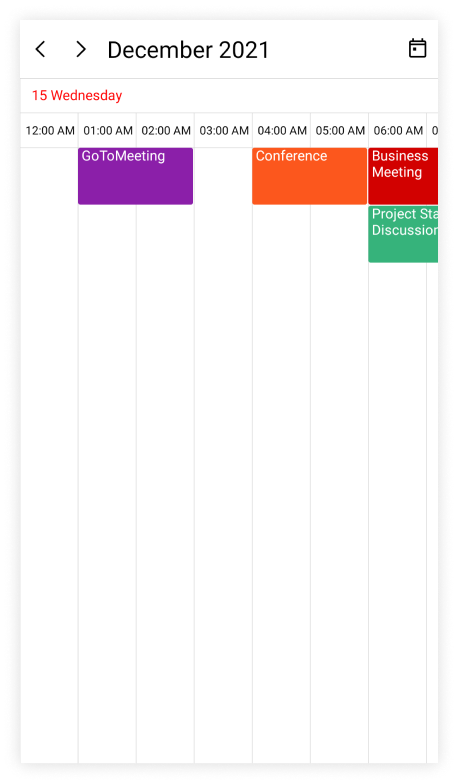
Customize view header appearance using DataTemplate
You can customize the view header appearance by using the ViewHeaderTemplate property of TimelineView in the SfScheduler.
<scheduler:SfScheduler x:Name="Scheduler"
View="TimelineWeek">
<scheduler:SfScheduler.TimelineView>
<scheduler:SchedulerTimelineView>
<scheduler:SchedulerTimelineView.ViewHeaderTemplate>
<DataTemplate>
<Grid x:Name="grid" Background="MediumPurple" >
<Label x:Name="label" HorizontalOptions="Start" VerticalOptions="Center" TextColor="White" >
<Label.Text>
<MultiBinding StringFormat = "{}{0:dd} {1:ddd}" >
<Binding />
<Binding />
</MultiBinding >
</Label.Text >
<Label.Triggers >
<DataTrigger TargetType="Label" Binding="{Binding}" Value="{x:Static system:DateTime.Today}">
<Setter TargetName = "label" Property="TextColor" Value="Orange"/>
</DataTrigger>
</Label.Triggers>
</Label>
<Grid.Triggers>
<DataTrigger TargetType = "Grid" Binding="{Binding}" Value="{x:Static system:DateTime.Today}">
<Setter TargetName = "grid" Property="Background" Value="LightGreen"/>
</DataTrigger>
</Grid.Triggers>
</Grid>
</DataTemplate>
</scheduler:SchedulerTimelineView.ViewHeaderTemplate>
</scheduler:SchedulerTimelineView>
</scheduler:SfScheduler.TimelineView>
</scheduler:SfScheduler>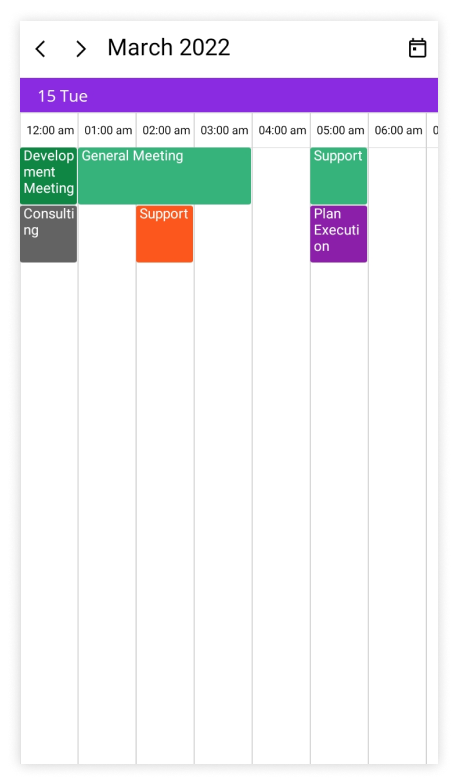
NOTE
- The BindingContext of the
ViewHeaderTemplateis theDateTime.TheSelectableDayPredicate,MinimumDateTime,andMaximumDateTimeproperties of date and time values can be used directly in the data template selector.
Customize view header appearance using DataTemplateSelector
You can customize the view header appearance by using the ViewHeaderTemplate property of TimelineView in the SfScheduler. The DataTemplateSelector can choose a DataTemplate at runtime based on the value of a data-bound to scheduler view header by using the ViewHeaderTemplate. It allows you to choose a different data template for each view header, as well as customize the appearance of a particular view header based on certain conditions.
<Grid>
<Grid.Resources>
<DataTemplate x:Key="normalDateTemplate">
<Grid x:Name="grid" Background="MediumPurple" >
<Label x:Name="label" HorizontalOptions="Start" VerticalOptions="Center" TextColor="White" >
<Label.Text>
<MultiBinding StringFormat = "{}{0:dd} {1:ddd}" >
<Binding />
<Binding />
</MultiBinding >
</Label.Text >
</Label>
</Grid>
</DataTemplate>
<DataTemplate x:Key="todayDateTemplate">
<Grid x:Name="grid" Background="MediumPurple" >
<Label x:Name="label" HorizontalOptions="Start" VerticalOptions="Center" TextColor="Yellow" >
<Label.Text>
<MultiBinding StringFormat = "{}{0:dd} {1:ddd}" >
<Binding />
<Binding />
</MultiBinding >
</Label.Text >
</Label>
</Grid>
</DataTemplate>
<local:ViewHeaderTemplateSelector x:Key="viewHeaderTemplateSelector" TodayDateTemplate="{StaticResource todayDateTemplate}" NormalDateTemplate="{StaticResource normalDateTemplate}"/>
</Grid.Resources>
<scheduler:SfScheduler x:Name="Scheduler"
View="TimelineWeek" >
<scheduler:SfScheduler.TimelineView>
<scheduler:SchedulerTimelineView ViewHeaderTemplate="{StaticResource viewHeaderTemplateSelector}" />
</scheduler:SfScheduler.TimelineView>
</scheduler:SfScheduler>
</Grid>public class ViewHeaderTemplateSelector : DataTemplateSelector
{
public ViewHeaderTemplateSelector()
{
}
public DataTemplate NormalDateTemplate { get; set; }
public DataTemplate TodayDateTemplate { get; set; }
protected override DataTemplate OnSelectTemplate(object item, BindableObject container)
{
var dateTime = (DateTime)item;
if (dateTime.Date == DateTime.Today.Date)
return TodayDateTemplate;
else
return NormalDateTemplate;
}
}this.Scheduler.View = SchedulerView.TimelineWeek;NOTE
- The BindingContext of the
ViewHeaderTemplateis theDateTime.TheSelectableDayPredicate,MinimumDateTime,andMaximumDateTimeproperties of date and time values can be used directly in the data template selector.- When using data template selector, performance issues occur as the conversion template views take time within the framework.
Time text formatting
The format for the labels mentioning the time can be customized by setting the TimeFormat property of TimelineView in the SfScheduler.
<scheduler:SfScheduler x:Name="Scheduler"
View="TimelineWeek">
<scheduler:SfScheduler.TimelineView>
<scheduler:SchedulerTimelineView
TimeFormat="hh:mm" />
</scheduler:SfScheduler.TimelineView>
</scheduler:SfScheduler>SfScheduler scheduler = new SfScheduler();
scheduler.View = SchedulerView.TimelineWeek;
scheduler.TimelineView.TimeFormat = "hh:mm";
this.Content = scheduler;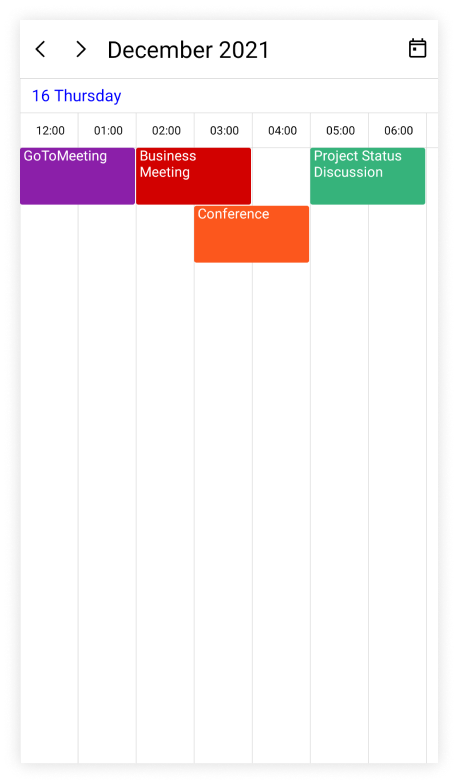
NOTE
- By default, the scheduler time text format is
hh:mm tt.
Customize time ruler text style
The text style for the labels mentioning the time can be customized, by setting the TimeRulerTextStyle properties of TimelineView in the SfScheduler.
<scheduler:SfScheduler x:Name="Scheduler"
View="TimelineWeek">
</scheduler:SfScheduler>this.Scheduler.View = SchedulerView.TimelineWeek;
var timeRulerTextStyle = new SchedulerTextStyle()
{
TextColor = Colors.Red,
FontSize = 12,
};
this.Scheduler.TimelineView.TimeRulerTextStyle = timeRulerTextStyle;
